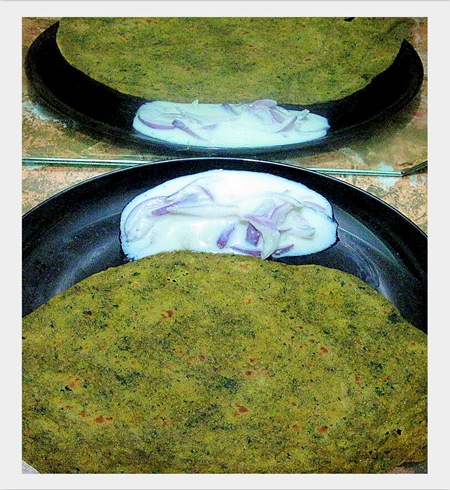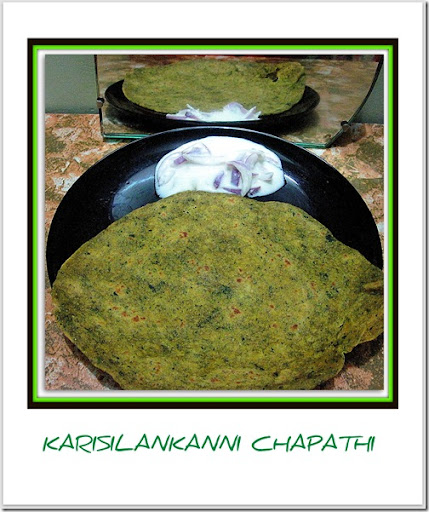Nowadays i am using karisilankanni keerai in my cooking twice a week for health reasons. I make kootu and this chapathi.But i would say,we love this chapathi more than kootu ;) It is very easy to prepare.I make this for my hubby's lunch box. It stays soft and onion raita is the best accompaniment. I use the same method to prepare palak and other keerai chapathis.

INGREDIENTS
- Karisalankanni leaves- 1 bunch
- Wheat flour - 1 cup
- Besan flour - 1 tbsp
- Sambhar powder - 1 tsp
- Garam masala - 1/2 tsp
- Curd - 1/5 cup ( adjust)
- Olive oil - 1 tsp
- Salt -as needed
- water - As needed
|
METHOD
- Wash the leaves .Heat the kadai with a tsp of oil and saute the leaves till it reduces to half in quantity.
- Grind to make a smooth paste by adding little curd . Now in a bowl , take the wheat flour,besan flour , sambhar & garam masala powder,salt and water.Knead well to make a soft , pliable dough.
- Roll to make thin chapathi and toast on a dosa tawa.
- Serve hot with onion raita and pickle.

KITCHEN CLINIC
| Karisalankanni (Eclipta prostrata) is the herb of choice in treating liver diseases. This herb grows in marshy areas throughout the year. It grows abundantly during the rainy season. There are two varieties of karisilankanni, one has yellow flowers and the other white. The yellow one is more potent. Karisalankanni is most effective when eaten raw. It can also be dried in shade and powdered.
Medicinal properties
 karisalankanni is also a specific remedy for jaundice. It has a great medicinal value in the treatment of hair. Karisalankanni is said to protect against night blindness and other eye diseases probably because of its high carotene content. karisalankanni is also a specific remedy for jaundice. It has a great medicinal value in the treatment of hair. Karisalankanni is said to protect against night blindness and other eye diseases probably because of its high carotene content.
Uses
1. It is good for teeth, skin and hair.
2. It induces appetite.
3. It aids digestion and helps expel fecal matter from the large intestines.
4. It heals ulcers.
5. It cleans the liver and encourages secretion of bile.
6. It cures inflamed liver also called fatty liver.
7. It expels intestinal worms, cures coughs and asthma, and tones the body.
8. The yellow variety is said to be particularly good for the skin and eyes.
When ground to a paste and cooked as in karislankanni kootu, it is good for teeth, skin and hair. It induces appetite. It aids digestion and helps expel fecal matter from the large intestines. It heals ulcers. It cleans the liver and encourages secretion of bile. It cures inflamed liver also called fatty liver.
Adulterated food can jeopardise the liver. Also foods contaminated with chemicals can play havoc. All these on entering human body should to be expelled and the liver is strained beyond its limit. This results in sluggish liver, stomach upset and gastroenteritis. Even though we consume nutritive foods in plenty than the previous generations it doesn't seem to strengthen our immune system. This is because of the loss of coordination between the liver, intestines and stomach. Adulterated food, contaminated water and polluted environment are the factors that are to be blamed for this state of affairs. There is a high risk of hypercholesterolemia, high blood pressure, cirrhosis, atherosclerosis and coronary thrombosis.
Karisalankanni comes to rescue in such cases. One ounce of karisalankanni juice (15 ml) and cow's milk 20 ml (boiled and then brought down to the room temperature) are mixed and should be taken first thing in the morning. This regulates the blood pressure as well.
As karisalankanni starts working in the system, it sets right the liver and cures jaundice, fatty liver, splenomegaly, hemorrhoids, indigestion etc. Regular intake strengthens the inner organs.
|





 karisalankanni is also a specific remedy for jaundice. It has a great medicinal value in the treatment of hair. Karisalankanni is said to protect against night blindness and other eye diseases probably because of its high carotene content.
karisalankanni is also a specific remedy for jaundice. It has a great medicinal value in the treatment of hair. Karisalankanni is said to protect against night blindness and other eye diseases probably because of its high carotene content.
No hay comentarios:
Publicar un comentario